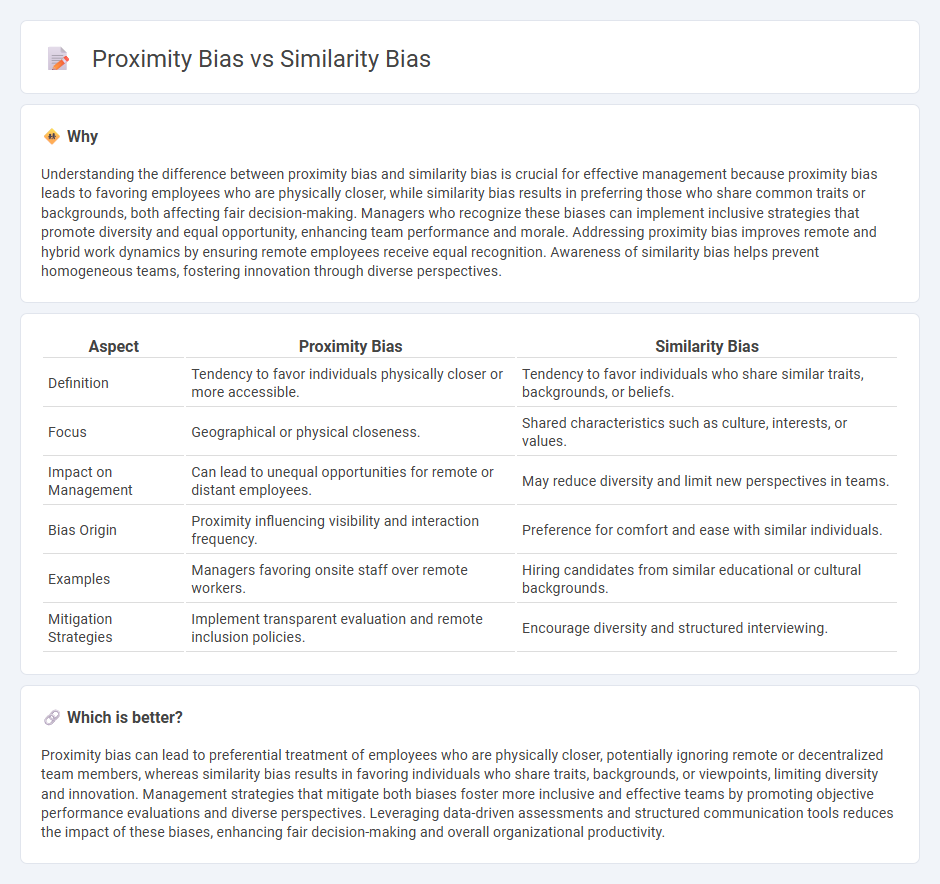
Proximity bias occurs when managers favor employees who are physically closer, often leading to unfair advantages in remote or hybrid work environments. Similarity bias involves preferring individuals who share similar traits, backgrounds, or beliefs, which can hinder diversity and innovation within teams. Explore effective strategies to identify and mitigate these biases to foster a more equitable workplace culture.
Why it is important
Understanding the difference between proximity bias and similarity bias is crucial for effective management because proximity bias leads to favoring employees who are physically closer, while similarity bias results in preferring those who share common traits or backgrounds, both affecting fair decision-making. Managers who recognize these biases can implement inclusive strategies that promote diversity and equal opportunity, enhancing team performance and morale. Addressing proximity bias improves remote and hybrid work dynamics by ensuring remote employees receive equal recognition. Awareness of similarity bias helps prevent homogeneous teams, fostering innovation through diverse perspectives.
Comparison Table
| Aspect | Proximity Bias | Similarity Bias |
|---|---|---|
| Definition | Tendency to favor individuals physically closer or more accessible. | Tendency to favor individuals who share similar traits, backgrounds, or beliefs. |
| Focus | Geographical or physical closeness. | Shared characteristics such as culture, interests, or values. |
| Impact on Management | Can lead to unequal opportunities for remote or distant employees. | May reduce diversity and limit new perspectives in teams. |
| Bias Origin | Proximity influencing visibility and interaction frequency. | Preference for comfort and ease with similar individuals. |
| Examples | Managers favoring onsite staff over remote workers. | Hiring candidates from similar educational or cultural backgrounds. |
| Mitigation Strategies | Implement transparent evaluation and remote inclusion policies. | Encourage diversity and structured interviewing. |
Which is better?
Proximity bias can lead to preferential treatment of employees who are physically closer, potentially ignoring remote or decentralized team members, whereas similarity bias results in favoring individuals who share traits, backgrounds, or viewpoints, limiting diversity and innovation. Management strategies that mitigate both biases foster more inclusive and effective teams by promoting objective performance evaluations and diverse perspectives. Leveraging data-driven assessments and structured communication tools reduces the impact of these biases, enhancing fair decision-making and overall organizational productivity.
Connection
Proximity bias and similarity bias are interconnected cognitive tendencies that affect managerial decision-making by favoring employees who are physically closer or share similar characteristics with the manager. Proximity bias leads managers to give preferential treatment to those nearby, while similarity bias causes favoritism towards individuals with comparable backgrounds or traits, reinforcing workplace inequalities. Understanding this connection helps organizations develop fairer evaluation and collaboration practices by promoting diversity and inclusivity.
Key Terms
Unconscious bias
Similarity bias leads individuals to favor others who share common traits, such as backgrounds, interests, or opinions, while proximity bias causes a preference for those physically closer, especially in workplace settings. Both biases operate unconsciously, influencing decisions and interactions without deliberate awareness, often undermining diversity and inclusivity efforts. Explore deeper insights into managing unconscious bias effectively by understanding these dynamics.
Decision-making
Similarity bias leads decision-makers to favor individuals who share their traits, values, or backgrounds, potentially limiting diverse perspectives and innovation. Proximity bias causes preference for those physically closer, often impacting remote team evaluations and hindering fair assessments. Explore how addressing these biases can improve strategic decision-making and organizational outcomes.
Diversity and inclusion
Similarity bias causes individuals to favor others who share common traits, limiting workplace diversity by reinforcing homogeneity. Proximity bias influences managers to prefer employees who are physically closer, often marginalizing remote or geographically distant talent and hindering inclusive practices. Explore strategies to mitigate these biases and foster a truly diverse and inclusive work environment.
Source and External Links
What is Similarity Bias? Definition, Types, Examples - HiPeople - Similarity bias, also called affinity bias, is the tendency to favor individuals who share similar characteristics such as backgrounds or interests, leading to comfort and familiarity but potentially limiting diversity and innovation in workplaces.
What is Affinity/similarity Bias - Definition & Examples in Recruitment - Similarity bias is the tendency to favor people with shared traits or experiences, like the same cultural background or schooling, especially in recruitment and promotion, which can unconsciously disadvantage more qualified candidates without those similarities.
The Similar-To-Me Effect - The Decision Lab - The similar-to-me effect describes our cognitive bias to prefer people who resemble ourselves in characteristics, beliefs, or experiences, often called affinity bias, which can lead to unfair outcomes in hiring and workplace inclusion.
 dowidth.com
dowidth.com